
Gaspard Dughet, a prominent figure in the world of Baroque landscape painting, stands as a fascinating artist whose life and work were intrinsically tied to the city of Rome and its surrounding countryside, the Campagna. Though often known by the surname of his famous brother-in-law, Nicolas Poussin, Dughet carved out a distinct and influential path for himself. He specialized in capturing the unique atmosphere, topography, and even the dramatic weather of the Roman environs, creating works that resonated deeply with contemporaries and left a lasting legacy, particularly influencing artistic tastes in Britain centuries later. His art bridges the structured classicism associated with Poussin and the lyrical, atmospheric approach of Claude Lorrain, resulting in a powerful and personal vision of nature.
Forging an Identity: Early Life in Rome
Gaspard Dughet entered the world in Rome on June 4, 1615. His parentage reflected a blend of cultures, with a French father, reportedly a cook, and an Italian mother. This dual heritage perhaps prefigured his artistic position, comfortable within the Italian artistic milieu yet connected to French artistic currents through family. Crucially, Rome was not just his birthplace; it became the lifelong center of his artistic activity and the primary subject of his extensive oeuvre. He lived and worked almost exclusively in the city, absorbing its unique blend of ancient ruins, rolling hills, and vibrant artistic life during the height of the Baroque period. He passed away in his native city on May 25, 1675.
The Shadow and Light of Poussin
The single most significant relationship in Dughet's early artistic life was undoubtedly with Nicolas Poussin, the preeminent French classical painter who had established himself in Rome. This connection was forged through family ties: around 1630, Poussin married Gaspard's elder sister, Anne-Marie Dughet. This familial bond led to Gaspard entering Poussin's household and studio, likely around 1635, becoming his pupil.
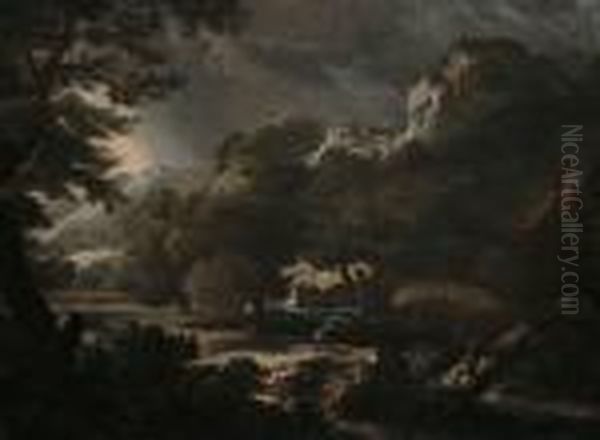
This association was so strong that Gaspard frequently became known as "Gaspard Poussin" or, affectionately, "Le Guaspre Poussin" or even "Poussinou." This alias stuck throughout his career and long after, sometimes causing confusion but also indicating the perceived closeness of their artistic relationship, at least initially. While Poussin's direct instruction provided Dughet with a foundation in composition and perhaps instilled a sense of classical order, art historians generally agree that Dughet quickly developed his own distinct approach.
The influence of Poussin is most discernible in Dughet's earlier works, which sometimes exhibit a more structured, architectural approach to landscape composition. However, the precise nature of their studio relationship remains debated. Some scholars have even speculated whether the young Dughet might have assisted Poussin with landscape backgrounds in some of the master's earlier paintings, though concrete evidence is lacking. What is clear is that Poussin provided a crucial entry point into the Roman art world and foundational training.
Despite adopting the Poussin name for professional advantage and recognition, Dughet's artistic temperament leaned more towards a direct, sometimes even tempestuous, engagement with nature itself, rather than the highly intellectualized, history-focused narratives that characterized much of Poussin's output. The connection, therefore, was one of family, initial training, and shared environment, rather than a simple continuation of Poussin's specific artistic philosophy. Academic circles often prefer the use of "Dughet" to emphasize his independent artistic identity and style.
Emergence of a Personal Vision
After his initial period under Poussin's guidance, Gaspard Dughet began to cultivate a more personal artistic style. While retaining a sense of classical structure learned from his brother-in-law, his work increasingly embraced a more naturalistic and atmospheric approach to landscape. A key influence in this development was arguably the other giant of Baroque landscape painting active in Rome: Claude Lorrain.
Claude, renowned for his poetic depictions of the Roman Campagna bathed in golden light and his mastery of aerial perspective, offered a different model from Poussin's stern classicism. Dughet seems to have absorbed elements from both masters, forging a synthesis that was uniquely his own. He balanced Poussin's sense of solid form and compositional structure with Claude's sensitivity to light, atmosphere, and the lyrical qualities of the landscape.
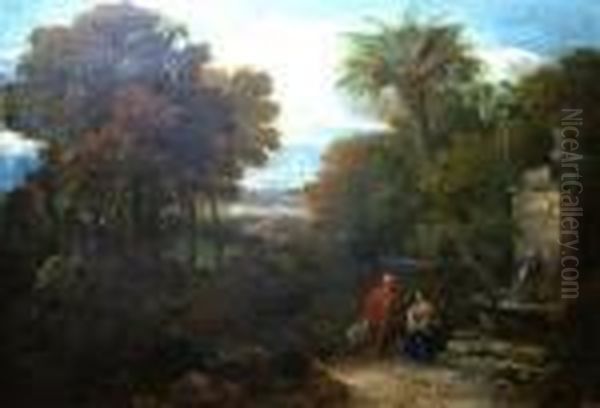
Dughet's true passion lay in the direct observation and depiction of the Roman Campagna – the countryside surrounding the city, with its rolling hills, ancient ruins, dramatic umbrella pines, and winding rivers. He spent considerable time exploring areas like Tivoli, Frascati, and the Alban Hills, sketching directly from nature (though his finished paintings were composed in the studio, following common practice). This dedication resulted in works that felt authentic and deeply familiar with the specific character of the local terrain.
His landscapes often convey a sense of dynamism and untamed nature that distinguishes them from the more serene or idealized visions of Claude. Dughet was particularly drawn to depicting dramatic weather effects, becoming renowned for his powerful storm scenes, where wind lashes through trees, clouds gather menacingly, and lightning illuminates the land. This focus on the more turbulent aspects of nature added an emotional intensity to his work.
Mastering the Elements: Style and Technique
Gaspard Dughet's mature style is characterized by several key features. His compositions often employ strong diagonal lines, created by winding paths, riverbanks, or receding hills, drawing the viewer's eye into the landscape. Trees are frequently prominent elements, depicted with vigorous, expressive brushwork that captures the texture of bark and the movement of foliage, especially under wind. Unlike Poussin's often static figures drawn from mythology or history, Dughet's small figures are typically shepherds, travelers, or hunters, serving primarily to establish scale and animate the scene rather than convey complex narratives.
His handling of paint could be quite fluid and energetic, particularly in his easel paintings, contributing to the sense of immediacy and natural force in his work. This contrasts with the more polished, meticulous finish often found in the works of Claude Lorrain or the intellectual rigour of Poussin. Dughet's palette generally favoured earthy tones – greens, browns, ochres – reflecting the colours of the Campagna, often punctuated by the cool blues and greys of skies, especially in his storm scenes.
Dughet was proficient in both oil painting on canvas and the demanding technique of fresco painting. His frescoes, often large-scale decorative cycles in Roman palaces and churches, allowed him to create immersive landscape environments. In these works, his compositional skills came to the fore, adapting naturalistic scenes to architectural settings. He often integrated classical ruins or pastoral buildings seamlessly into his landscapes, evoking a sense of timelessness and the interplay between nature and human history that was so palpable in the Roman countryside.
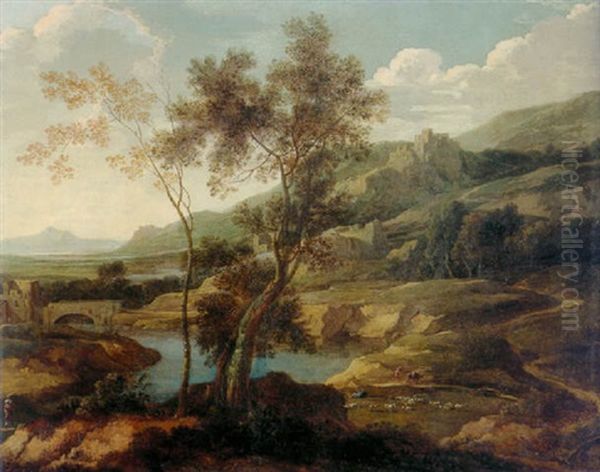
His reputation for depicting storms became one of his defining characteristics. These works capture the sublime power of nature, showcasing his ability to render dramatic light effects, turbulent skies, and wind-swept vegetation. These scenes stood apart from the tranquil, sun-drenched pastorals more commonly associated with Claude, offering a more romantic and emotionally charged vision of the landscape.
Monumental Landscapes: Major Commissions and Works
While Dughet produced numerous easel paintings sought after by collectors, some of his most significant contributions were large-scale fresco cycles commissioned for prominent Roman locations. These projects cemented his reputation as a leading landscape specialist in the city.
Perhaps his most celebrated fresco cycle is the series depicting scenes from the Life of the Prophet Elijah, painted in the Carmelite church of San Martino ai Monti in Rome. Executed likely in the 1650s, these frescoes demonstrate Dughet's ability to integrate narrative elements within expansive, atmospheric landscapes. The dramatic life of the prophet provided ample opportunity for Dughet to showcase his skills in depicting rugged mountains, stormy skies, and moments of divine intervention within nature. These works are considered masterpieces of Baroque landscape fresco painting.
Another major commission was for the Palazzo Doria Pamphilj on the Via del Corso in Rome. Here, Dughet painted an extensive series of landscapes, contributing significantly to the palace's lavish decoration program initiated by Pope Innocent X Pamphilj. These frescoes, found in several rooms, transform the interior walls into vistas of the Roman Campagna, showcasing various moods and times of day. They exemplify his ability to create decorative ensembles that brought the beauty and grandeur of the surrounding countryside indoors. He also worked on commissions for other notable Roman families and palaces, including the Palazzo Colonna.
Among his easel paintings, works like Landscape with Storm capture his signature dramatic flair. Other typical subjects include views of Tivoli, often featuring its famous waterfalls and temples, or panoramic vistas of the Campagna. A well-known example in a public collection is Landscape with Abraham Sacrificing Isaac (National Gallery, London), which, while featuring a biblical story, places the figures within a vast, meticulously rendered landscape that dominates the composition, typical of his approach where nature often takes precedence over narrative.
A Network of Artists: Contemporaries and Collaborators
Gaspard Dughet operated within a vibrant artistic community in Rome, interacting with and being influenced by numerous other painters. His relationship with Nicolas Poussin and Claude Lorrain has already been discussed as foundational. Beyond these giants, he had significant connections with other artists.
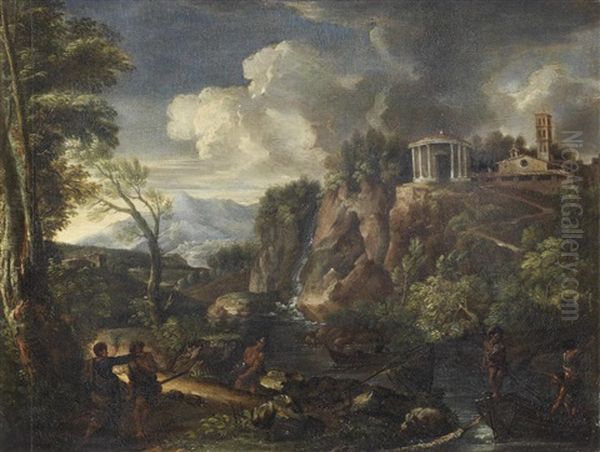
He maintained a close association with Salvator Rosa, another prominent landscape painter known for his wild, romantic, and often turbulent scenes featuring bandits, hermits, and dramatic natural settings. While their styles differed – Rosa's often being more rugged and overtly 'sublime' – they shared an interest in the untamed aspects of nature and are sometimes seen as representing complementary facets of Baroque landscape. There is evidence suggesting they occasionally collaborated or at least moved in similar circles.
Dughet frequently collaborated with figure painters, as was common practice. One of his most regular collaborators was Guillaume Courtois (also known as Guglielmo Cortese or Il Borgognone), a French painter active in Rome specializing in battle scenes and figures. In many instances, Dughet would paint the expansive landscape settings, and Courtois would add the figures, creating a seamless blend of their respective talents.
During his work at the Palazzo Pamphilj in Piazza Navona, Dughet collaborated with other artists involved in the extensive decorative project, including figure painters like Pierre Francesco Mola and Francesco Cozzia Mattia. These collaborations highlight the integrated nature of large-scale Baroque decorative schemes, where specialists in different genres worked together under a unified plan.
Dughet's work also shows an awareness of earlier landscape traditions. The influence of Agostino Tassi, Claude Lorrain's teacher, who was himself a significant landscape and decorative painter, can be discerned in the broader context of Roman landscape painting. Furthermore, Dughet worked alongside Northern European artists who flocked to Rome, the so-called 'Italianates'. Painters like Herman van Swanevelt and Jan Both, who specialized in idealized Italian landscapes bathed in warm light, were contemporaries, contributing to the rich tapestry of landscape painting in the city. Though Dughet's style remained distinct, he was undoubtedly part of this international exchange of ideas.
His influence extended to later generations. The Flemish painter Jan Frans van Bloemen, known as 'Orizzonte', arrived in Rome shortly after Dughet's death and became highly successful painting landscapes clearly indebted to Dughet's style and subject matter. In Britain, painters like Richard Wilson would later look to Dughet, alongside Claude, as key models for classical landscape painting. Thus, Dughet was not an isolated figure but an active participant and influential force within a wide network of artists spanning several nationalities and generations.
The Call of the Wild: Hunting and Final Years
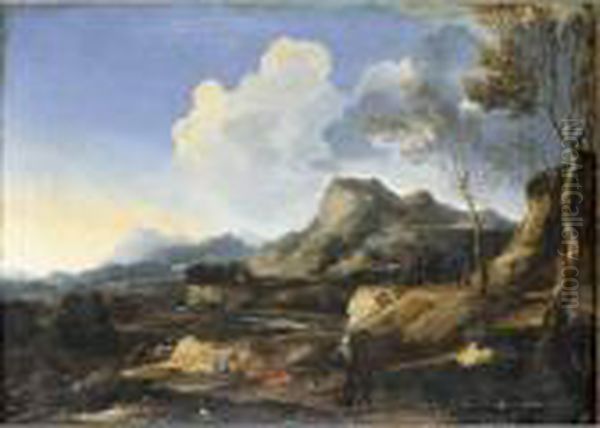
Beyond the studio, Gaspard Dughet was known for his passionate love of hunting. This pursuit was more than just a pastime; it seems to have been deeply ingrained in his character and directly informed his art. His frequent excursions into the Roman Campagna were not solely for sketching; they were also opportunities to engage in the chase. This intimate, active relationship with the wilderness undoubtedly contributed to the vitality and authenticity of his landscape depictions. He knew the terrain not just as an observer, but as a participant in its rhythms.
However, this rugged outdoor life took a toll on his health. Contemporary accounts, such as those by his biographer Filippo Baldinucci, mention that Dughet's relentless pursuit of game in all kinds of weather led to recurring illnesses. He reportedly suffered from gout and other ailments exacerbated by exposure. One anecdote even claims he experienced a period of paralysis due to his exertions in the field.
This dedication to his passion, while enriching his art, ultimately contributed to his relatively early death. Gaspard Dughet passed away in Rome in 1675 at the age of 60. His life, marked by intense artistic production and an equally intense engagement with the natural world he depicted, came to a close in the city that had been his lifelong home and inspiration.
Echoes Through Time: Legacy and Influence
While Gaspard Dughet enjoyed considerable success during his lifetime, particularly as a fresco painter, his posthumous reputation soared, especially in the 18th century and most notably in Great Britain. As the Grand Tour became fashionable among the British aristocracy, collectors developed a strong appetite for Italian landscape paintings that evoked the classical world and the beauty of the Italian countryside.
Dughet's works, alongside those of Claude Lorrain, became highly sought after. His landscapes, which balanced classical structure with naturalistic detail and often possessed a certain picturesque ruggedness, appealed greatly to British tastes. They were seen as ideal representations of the Italian landscape, embodying both the Arcadian ideal and a sense of natural grandeur. Many of his paintings entered important British collections and country houses.
His influence extended beyond collecting into the realm of artistic practice and even garden design. British landscape painters, particularly Richard Wilson, who spent time in Italy, looked to Dughet's compositions and atmospheric effects as models for their own depictions of both Italian and British scenery. Furthermore, Dughet's paintings became touchstones for the creators of English landscape gardens. The idealized yet naturalistic views he painted, often featuring winding paths, clumps of trees, and integrated classical elements, provided inspiration for landscape architects seeking to recreate such scenes in the grounds of estates like Stourhead.
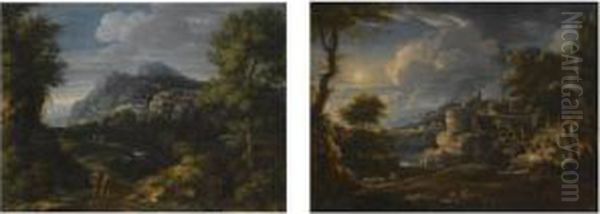
The enduring appeal of Dughet's work is evident in its continued presence in major museums around the world, including the Louvre in Paris, the Prado in Madrid, the Hermitage in St. Petersburg, the National Gallery in London, and numerous institutions in the United States. Though sometimes overshadowed by the towering figures of Poussin and Claude, Dughet holds a secure and important place in the history of art.
His specific focus on the Roman Campagna, his mastery of atmospheric effects, particularly storms, and his ability to synthesize different stylistic currents into a coherent personal vision mark him as a key figure in the development of European landscape painting. He captured the unique spirit of the Roman countryside with an authenticity and passion that continues to resonate with viewers today.
Conclusion: A Singular Vision of the Roman Countryside
Gaspard Dughet stands as a pivotal figure in Baroque landscape painting, a master whose identity was forged in Rome and whose art remains inextricably linked to its surrounding Campagna. Navigating the powerful influences of his brother-in-law Nicolas Poussin and contemporary Claude Lorrain, Dughet crafted a unique artistic voice. He combined Poussin's structural solidity with Claude's atmospheric lyricism, adding his own distinct sensitivity to the dynamism and specific character of the Roman landscape.
Known both as Dughet and Gaspard Poussin, his work encompasses grand fresco cycles in Roman palaces and churches, like San Martino ai Monti, and numerous easel paintings capturing the varied moods of nature, from tranquil vistas to dramatic storms. His collaborations with artists like Guillaume Courtois and his place within a network including Salvator Rosa and the Dutch Italianates highlight his integration into the vibrant Roman art scene.
His passionate engagement with nature, extending to his love of hunting, infused his work with vitality but perhaps shortened his life. Posthumously, his influence surged, particularly in 18th-century Britain, where his landscapes became prized possessions and models for both painters like Richard Wilson and landscape garden designers. Gaspard Dughet's enduring legacy lies in his powerful, authentic, and often dramatic portrayal of the Roman countryside, securing his position as a crucial and distinctive master of European landscape art.